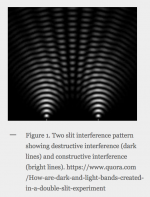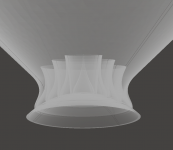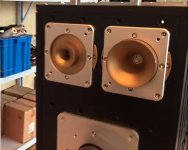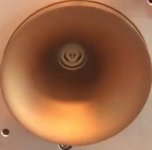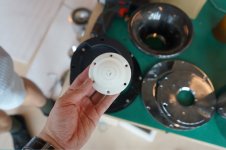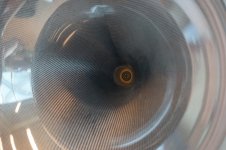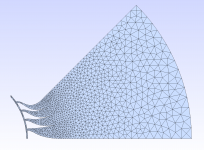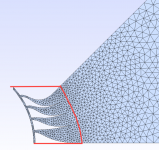As depicted, the outer slot spacing is roughly the diaphragm diameter.Five slots.
The destructive interference pattern caused by the slot spacing for diaphragms over about 25mm will reduce HF output above 10kHz compared to the usual phase plug arrangement that allows a reduction in slot spacing compared to diaphragm size.
In addition to those losses, a diaphragm will be more prone to deformation when compression force is greater on the convex rather than the concave side. To reduce deformation would require a heavier diaphragm, which would will lower the mass roll-off frequency, reducing HF even more compared to the usual phase plug arrangement.
Art
Attachments
Thanks for the input. I probably need to see the results myself as I'm not sure about the interference. On your picture the curvatures of the two wavefronts are very different compared to their distance which of course leads to a strong interference. But as I try to do it, there should be no such curvature mismatch, hopefully. For now I just see no reason why that would be inevitable. All the slots are working together, not just the two outer ones.
My reasoning is that if it really behaved as a pulsating source as a whole (which is what I'm trying to achieve), the size would be just irrelevant.
My reasoning is that if it really behaved as a pulsating source as a whole (which is what I'm trying to achieve), the size would be just irrelevant.
Last edited:
So the more it behaves as a pulsating source, the more is the size irrelevant. This should hold, as far as I can see. The question is how close it gets.
Thanks for the input. I probably need to see the results myself as I'm not sure about the interference. On your picture the curvatures of the two wavefronts are very different compared to their distance which of course leads to a strong interference. But as I try to do it, there should be no such curvature mismatch, hopefully. For now I just see no reason why that would be inevitable. All the slots are working together, not just the two outer ones.
My reasoning is that if it really behaved as a pulsating source as a whole (which is what I'm trying to achieve), the size would be just irrelevant.
I tend to agree with this analysis. Any spatial effects from the quantum spacing of the channels (like suggested, if they occur) would not likely ever reach the mouth anyways. The wavefront across the mouth tends to be a heavily averaged contour of the throat. Small variations simply won't be seen at the mouth until a very high frequency. Far too high to worry about.
I think that what you are doing has merit. But, of course, proving it out is no small task. Good luck!
That principle "looks" promising.
It resembles "supposed superior phase plugs" that I have seen on Asian websites.
Apologies for the vague images, these are stills from a video shot by a lady who continuously moved the camera.
It resembles "supposed superior phase plugs" that I have seen on Asian websites.
Apologies for the vague images, these are stills from a video shot by a lady who continuously moved the camera.
Attachments
Last edited:
The plug of the midrange horn driver looks more conventional.
Attachments
Last edited:
Yeah, that is very much how it would look like when seen from outside. Now the question is whether the dome behind is convex or concave. If it was convex, I'd be most interested to see their results. Based on some of the images I think it will be the conventional design though.
- Ah, now I noticed the photo of the back side of the phase plug. Then it is the conventional design where a flat exit wavefront is the target.
- Ah, now I noticed the photo of the back side of the phase plug. Then it is the conventional design where a flat exit wavefront is the target.
Last edited:
BTW, a "shortcoming" of the design I've presented is that a plane wave tube is no longer an option of how to measure it. You would need a "spherical wave cone" and that would be somewhat impractical, occupying much of the room.
Now, when I have the PWTs almost finished. 😱 🙂
Now, when I have the PWTs almost finished. 😱 🙂
Last edited:
Thank you. I post it here as any remarks or notions are highly welcome. There must be tons of existing knowledge I have no inkling about. This is really not my expertise.I tend to agree with this analysis. Any spatial effects from the quantum spacing of the channels (like suggested, if they occur) would not likely ever reach the mouth anyways. The wavefront across the mouth tends to be a heavily averaged contour of the throat. Small variations simply won't be seen at the mouth until a very high frequency. Far too high to worry about.
I think that what you are doing has merit. But, of course, proving it out is no small task. Good luck!
Thinking out loud, wouldn't elliptical entrances of the phase plug channels mitigate the modal issues, i.e. wouldn't it "smear" the contributions of different modes to the channel excitation? The exit could remain circular, only the entrances could be made some other shape, maybe. If this "averaging out" works, it might allow for some slight variations of the path lengths around the slot. 

Last edited:
Mabat,ABEC observation fields will be used to analyze the behaviour.
I can't help but observe that neither a concave or a convex diaphragm behave like a section of a "pulsating sphere", which seems to be your goal.
Functionally, your throat output appears to be nearly identical to the diaphragm shape, no closer to a pulsating sphere than the diaphragm itself.
The reduction slits at the diaphragm don't provide any useful compression loading, as the output Sd of those slots is equal to the diaphragm Sd.
At very high frequencies, the sound power delivered into the slots won't exceed half the power of the wave arriving at the "T" junction, so your "phase plug" would actually reduce HF level compared to the diaphragm used without.
Art
Attachments
We are not at the same page here, I guess. Actually, the compression ratio for the above example is 8:1 as it is the total slot entrance area that matters, not the throat area (which is not even clearly defined in this case). And I really do think that if done as I suggest the velocity entering the waveguide (i.e. at the exit of the slots) is much more closer to radial than for the diaphragm alone.
Unfortunately my first attempt for a simulation ended a while ago for "out of memory"...
Edit: I checked again and it is in fact more like 7:1 as I made some changes in the meantime. For a home use I think it would be harmless to reduce it.
Unfortunately my first attempt for a simulation ended a while ago for "out of memory"...
Edit: I checked again and it is in fact more like 7:1 as I made some changes in the meantime. For a home use I think it would be harmless to reduce it.
Last edited:
Could this be in theory used also for combining the output of multiple drivers properly?
I have seen a picture of a JBL driver (that I can't find at the moment) where the phase plug is designed to mate with a planar waveguide (for line array usage). The interface between the two was a wavey ring shaped channel.
- Home
- Loudspeakers
- Multi-Way
- Acoustic Horn Design – The Easy Way (Ath4)

